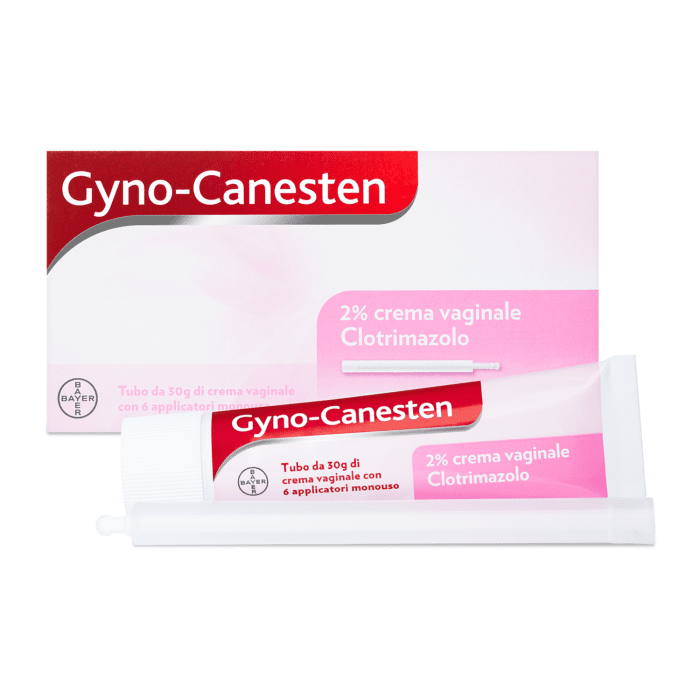BAYER SpA
Gynocanesten Vaginal Cream 30 g 2%
Gynocanesten Vaginal Cream 30 g 2%

Pickup available at Farmacia Tili
Usually ready in 24 hours
PRODUCT NET WEIGHT
PRODUCT NET WEIGHT
30g
EAN
EAN
025833068
MINSAN
MINSAN
025833068
Gynocanesten Vaginal Cream 30 g 2% is an antifungal drug indicated for the treatment of vaginal infections caused by fungi, such as vaginal candidiasis. The active ingredient, clotrimazole 2%, works by inhibiting the growth of fungi and promoting the recovery of the natural balance of the vaginal flora. The cream is particularly indicated for quickly relieving the symptoms associated with infections, such as itching, burning, irritation and abnormal vaginal discharge .
Gynocanesten Vaginal Cream is indicated for:
-
Treatment of vaginal candidiasis and other fungal infections of the genital area.
-
Relieve symptoms such as itching, burning and irritation caused by vaginal infections.
-
Restoration of natural vaginal flora .
ACTIVE INGREDIENTS
Active ingredients contained in Gynocanesten Vaginal Cream 30g 2% - What is the active ingredient of Gynocanesten Vaginal Cream 30g 2%?
GYNO-CANESTEN 2% vaginal cream. 5 g of vaginal cream contain; active ingredient: clotrimazole 100 mg. Excipient with known effect: cetostearyl alcohol and benzyl alcohol. GYNO-CANESTEN 100 mg vaginal tablets. One vaginal tablet contains active ingredient: clotrimazole 100 mg. For the full list of excipients, see section 6.1.
EXCIPIENTS
Composition of Gynocanesten Vaginal Cream 30g 2% - What does Gynocanesten Vaginal Cream 30g 2% contain?
GYNO-CANESTEN 2% vaginal cream: sorbitan stearate, polysorbate 60, cetyl palmitate, cetostearyl alcohol, octyldodecanol, benzyl alcohol, purified water. GYNO-CANESTEN 100 mg vaginal tablets: lactose monohydrate, corn starch, magnesium stearate, colloidal anhydrous silica, calcium lactate pentahydrate, crospovidone, lactic acid, hypromellose, microcrystalline cellulose.
DIRECTIONS
Therapeutic indications Gynocanesten Vaginal Cream 30g 2% - Why is Gynocanesten Vaginal Cream 30g 2% used? What is it for?
Treatment of localized symptoms such as itching, leucorrhoea, redness and sensation of swelling of the vaginal mucosa and glans, burning when passing urine when these symptoms are due to vulvovaginal infections and balanitis caused by previously diagnosed candida in adults and adolescents over 12 years of age.
CONTRAINDICATIONS SIDE EFFECTS
Contraindications Gynocanesten Vaginal Cream 30 g 2% - When should Gynocanesten Vaginal Cream 30 g 2% not be used?
Hypersensitivity to the active substance or to any of the excipients listed in paragraph 6.1.
DOSAGE
Quantity and method of taking Gynocanesten Vaginal Cream 30 g 2% - How to take Gynocanesten Vaginal Cream 30 g 2%?
Apply as deeply as possible into the vagina once a day, preferably in the evening, at bedtime. In case of vulvitis or Candida balanitis, apply a thin layer of Gyno-Canestencrema 2-3 times a day to the entire perineal area (urogenital and anal). In case of balanitis, also apply the cream to the foreskin. Facilitate absorption of the cream applied locally with a light massage. GYNO-CANESTEN 2% vaginal cream: apply as deeply as possible into the vagina once a day, preferably in the evening, at bedtime, for 3 consecutive days. If necessary, the treatment can be continued for another 3 days. Application method: the applicator should be used only once and then discarded in order to avoid possible infections. 1. Remove the piston from the disposable applicator until it stops. 2. Open the tube. Insert the disposable applicator into the latter and hold it firmly. Fill the applicator by carefully pressing on the tube. 3. Once you have assumed the supine position with your legs slightly bent, remove the disposable applicator, insert it as deeply as possible into the vagina and empty it by applying regular and continuous pressure on the piston. 4. Remove the applicator and discard it. GYNO-CANESTEN 100 mg vaginal tablets: apply one tablet as deeply as possible into the vagina once a day, preferably in the evening, at bedtime for six consecutive days or, alternatively, apply 2 for only 3 consecutive days. Method of application: after carefully washing your hands, once you have assumed the supine position with your legs slightly bent, insert the vaginal tablet directly with your finger as deeply as possible into the vagina. In chronic relapsing forms, the daily dosage may be increased to 2 vaginal tablets in the evening, for a period of 6-12 days. It is necessary for the vagina to have an adequate level of humidity to allow Gyno-Canesten vaginal tablets to dissolve completely. Otherwise, undissolved fragments of the tablet may fall out. To avoid this, it is important that the medicine is inserted as deeply as possible into the vagina at bedtime. If, despite this precaution, the tablet does not dissolve completely within one night, the use of vaginal cream should be considered. Duration of treatment: the maximum duration of treatment is 7 days, if symptoms persist, reassess the clinical picture. In case of vulvitis or balanitis, treatment should be continued for 1-2 weeks.
CONSERVATION
Storage Gynocanesten Vaginal Cream 30g 2% - How to store Gynocanesten Vaginal Cream 30g 2%?
GYNO-CANESTEN 2% vaginal cream: this medicine does not require any special storage conditions. GYNO-CANESTEN 100 mg vaginal tablets: store at a temperature not exceeding 25 degrees C.
WARNINGS
Warnings Gynocanesten Vaginal Cream 30g 2% - About Gynocanesten Vaginal Cream 30 g 2% it is important to know that:
In case of fever, lower abdominal pain, back pain, foul-smelling vaginal discharge, nausea, vaginal bleeding and/or shoulder pain, the clinical picture should be reassessed. Recurrent infections that recur within 2 months may be secondary to conditions such as diabetes or HIV infection that require thorough clinical examinations. It is preferable to start and finish treatment in the intermenstrual period. Tampons, vaginal douches, spermicides or other vaginal products should not be used during therapy with Gyno-Canesten. Recommend abstinence from vaginal intercourse because the infection could be transmitted to the partner. Furthermore, in order to avoid reinfection, particularly in the presence of Candida vulvitis or balanitis, recommend local treatment of the partner. During pregnancy, use vaginal tablets and insert them without the aid of the applicator. During treatment with Gyno-Canesten, the efficacy and safety of latex-based products, such as condoms and diaphragms, may be reduced. The use, especially if prolonged, of products for topical use may give rise to sensitization phenomena. In this case, it is necessary to interrupt the treatment and adopt appropriate therapeutic measures. Avoid contact with eyes. Do not ingest. Important information on some excipients. Gyno-Canesten cream contains cetostearyl alcohol: may cause local skin reactions (e.g. contact dermatitis). Gyno-Canesten cream contains 20 mg/g of benzyl alcohol: may cause allergic reactions; may cause mild local irritation.
INTERACTIONS
Interactions Gynocanesten Vaginal Cream 30g 2% - Which medicines or foods can modify the effect of Gynocanesten Vaginal Cream 30g 2%?'
Concomitant treatment with vaginal clotrimazole and oral tacrolimus (an immunosuppressant) may result in increased plasma levels of tacrolimus and similarly with sirolimus. Patients should therefore be carefully monitored for symptoms of tacrolimus or sirolimus overdose, if necessary by determination of plasma drug levels.
SIDE EFFECTS
Like all medicines, Gynocanesten Vaginal Cream 30g 2% can cause side effects - What are the side effects of Gynocanesten Vaginal Cream 30g 2%?
The adverse reactions listed below are indicated according to the MedDRA System Organ Class. Since they derive from spontaneous post-marketing reports, their frequency is indicated as not known (the frequency cannot be estimated from the available data). Immune system disorders: anaphylactic reaction, angioedema, hypersensitivity. Vascular disorders: syncope, hypotension. Respiratory, thoracic and mediastinal disorders: dyspnoea. Gastrointestinal disorders: abdominal pain, nausea. Skin and subcutaneous tissue disorders: rash, urticaria. Reproductive system and breast disorders: exfoliation, vaginal discharge, vaginal haemorrhage, discomfort, erythema, burning, pruritus, pain. Systemic disorders and conditions related to the administration site: application site irritation, edema, pain. Reporting of suspected adverse reactions. Reporting of suspected adverse reactions that occur after authorisation of the medicinal product is important. It allows continued monitoring of the benefit/risk balance of the medicinal product. Healthcare professionals are asked to report any suspected adverse reactions via the national reporting system at https://www.aifa.gov.it/content/segnalazioni-reazioni-avverse.
PREGNANCY AND BREASTFEEDING
If you are pregnant or breast-feeding, think you may be pregnant or are planning to have a baby, ask your doctor for advice before taking Gynocanesten Vaginal Cream 30g 2% Fertility: no studies have been conducted in humans on the effects of clotrimazole on fertility, however animal studies have not shown reproductive toxicity (see section 5.3). Pregnancy: available clinical data on the risk in pregnancy are limited. The administration of Gyno-canesten during pregnancy should be considered only if the expected benefit for the mother outweighs the risk for the fetus or child. Breast-feeding: no data are available on the excretion of clotrimazole in breast milk. However, systemic absorption is minimal after topical administration and is unlikely to lead to systemic effects. Clotrimazole can be used during breast-feeding.
OUR PRODUCTS FOR THIS SEASON

























